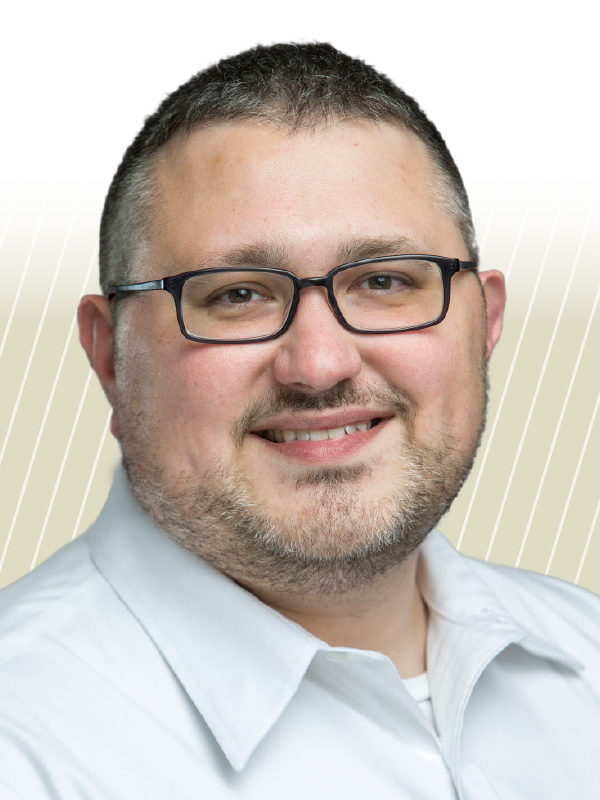Hal Jankowski met his wife, Stacie, through mutual friends during their undergraduate years at the University of Kentucky.
“We ran with the same crowd,” he recalls. “After we started hanging out together, we realized that our birthdays were a day apart. I’m older by a year and one day. One year, our friends said, ‘We’ll celebrate your birthdays all at once. At Stacie’s 21st birthday, we’ll go out and have a good time.’ We had a joint birthday celebration and hit it off that night. The rest is history.”
A tenor in his church choir for the last 15 years, Jankowski played the cello and piano in his younger days. “I’ve been involved with music for the vast majority of my life,” he says. “When I got older, I realized that I might not be as passionate about the cello or piano, but I was passionate about music. Your voice is an instrument you carry with you.”
He believes that singing in the choir has helped his career at the University of Cincinnati (UC), where he is the business officer for the College of Design, Architecture, Art, and Planning. “Joining the choir helped me develop the confidence to be in front of a group of people,” he says. “In my position, I give presentations to groups of faculty and administrators, and my confidence to contribute my ideas comes from the act of performing while singing.”
How did you become involved in higher education?
I started my career at Deloitte in Cincinnati as a tax consultant, where one of my first clients was a large manufacturing company. I figured out then that I wasn’t passionate about widgets. For my next assignment, I asked for clients in the nonprofit sector and ended up doing a consulting project for a large university.
When Stacie was admitted to a graduate program at Indiana University, we had been married for less than a year, and I wasn’t anxious to have a long-distance relationship as a newlywed. An opportunity came up at Indiana University for an auxiliary consultant. A couple of projects got me outside of my small accounting team, allowing me to build relationships across the university. Ultimately, I landed in the business function for the IT department.
Why did you and your family decide to move back to Cincinnati?
By the time Stacie finished her coursework and was at the dissertation stage, we had two young boys, Luke and Nathan. We were far away from family, making it difficult to manage family, and career obligations and expectations. Familyis incredibly important toboth of us. We agreed that we would look for opportunities in the Cincinnati area so that our children would be around family.

Since arriving at the University of Cincinnati, you have developed a revenue project model that is accurate within 1.4 percent. How does it work?
UC’s performance-based budgeting model is heavily dependent on being able to project revenue. The performance metric is revenue, which means that we get a fixed-expense budget annually that goes up or down, depending on how we perform to a revenue expectation. To plan for the future, we need to be able to project revenue for the college.
Because revenue in our college is dependent on enrollment, I need to understand by program—we have about 20 different programs—what the revenue contribution is for each. We also have a mandatory co-op for a number of programs, which means that a lot of programs tend to fall naturally into cohorts. So not only do I have to be able to figure out each program’s contribution to revenue, but I also need to understand the impact of the cohorts on that revenue.
To predict what will happen in the future, I work with our college’s senior assistant dean of student affairs, whose team tracks and identifies the people in the cohorts. I also work with the university’s student affairs division to identify enrollment trends, applicant pools, and the number of students qualified to be admitted to our programs.
What challenges did you face as you developed the model and how did you overcome them?
I started at UC in 2012, which was the first year that the university had changed to semesters. Consequently, most of the historical data was based on quarters, and the cohorts operated a little differently under quarters than they do under semesters. Since then, I’ve been able to explore that data and build a model for the college that has been reasonably accurate in predicting our revenue.
I understand that you reorganized administrative staff in your college. Why?
When I arrived in the college, we had an administrative staffing model that hadn’t been changed in a number of years. The College of Design, Architecture, Art, and Planning is divided into four schools: design, with just over 1,000 students, is our largest school; planning, with less than 200, is the smallest. The two support staff in planning served 12 faculty members and 200 students, while in the school of design, the same number of support staff served over 1,000 students and 25 faculty members.
Working with the dean and school directors, I came up with a quantitative method of reallocating headcount, looking specifically at the duties of the administrative staff.
Please explain that process.
We looked at the number of students and faculty, as well as the amount of money under management by each school, to come up with a proxy for the amount of work. The metric that generated the most work was the number of students, faculty, and adjuncts because that metric determined how many course add/drop slips needed to be signed, how many cohorts needed to be tracked, how many faculty were going on research trips, how many adjuncts needed to be hired, and how many courses need to be ordered.
Not only did we realign the number of staff, but we also rewrote the job descriptions to include analytical skills. The duties required of the previous positions were clerical in nature, such as typing forms and correspondence, which we were moving away from because of e-mail and online communication. School directors needed support staff with analytical skills to look at course enrollments and make recommendations on whether courses should run, as well as to track fund balances and point out those not being used.
When you reorganize staff and rewrite job descriptions, you end up with people whose jobs no longer exist in their current form.
Did the reorganization receive any pushback?
Not a lot. It was a collaborative process, and there was a place in the university for nearly all those folks to go. We were clear about what we were doing, why we were doing it, and what skills we were looking for in the newly revised positions.
Didn’t you present at a CACUBO workshop on data visualization?
Yes, the session introduced people to the power of visualization and what we can communicate by visualizing data. As business officers, we tend to operate in the world of spreadsheets and tables and numbers. We need to take the data that we deal with every single day and make it meaningful to the people who are making decisions.
For example, I work in a college of artists who are visually motivated. They want to see a picture, rather than a table of numbers. I’ve learned that I can’t just give school directors or faculty a spreadsheet; I need to show them the impact of the information with a graph or heat map.
What tools do you use?
I use the charting features in Excel, but it’s not just getting a data dump and putting a graph on top of it.
What role does social media play in your life?
It allows me to stay connected with a geographically diverse group of family and friends. Social media allows us to share the experience of our kids growing up and the funny things that they do, as well as their milestones—walking, losing teeth, the first day of school—with people we would otherwise have trouble keeping in touch with.
We are four months into the new year; did you and your family set any goals for the year? If so, how’s it going?
As a family, Stacie and I wanted to make healthier eating decisions and do a better job keeping our house in order, which can be a bit of a chaotic mess with two young children and both of us working. As far as how it’s going, I have no comment.
MARGO VANOVER PORTER, Locust Grove, Va., covers higher education business issues for Business Officer.



